
Mir is an urban-type settlement in Karelichy District, Grodno Region, Belarus. It is situated on the banks of Miranka River, about 85 kilometres (53 mi) southwest of the capital, Minsk.
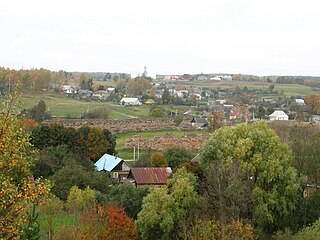
Kreva is an agrotown in Smarhon District, Grodno Region, Belarus. It serves as the administrative center of Krevas selsoviet.
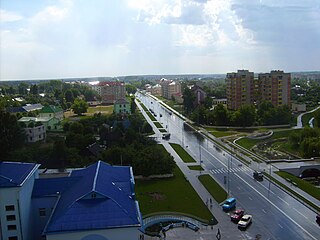
Ivatsevichy is a town in Brest Region, Belarus. It serves as the administrative center of Ivatsevichy District. As of 2023, it has a population of 22,487.

Antopal or Antopol is an urban-type settlement in Drahichyn District, Brest Region, Belarus. It is located near the towns of Kobryn and Brest. As of 2023, it has a population of 1,449.
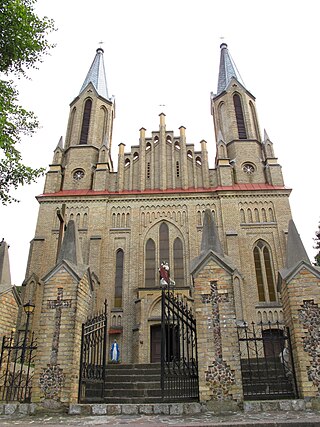
Krynkipronounced[ˈkrɨŋkʲi] is a town in northeastern Poland, located in Podlaskie Voivodeship along the border with Belarus. It lies approximately 24 kilometres (15 mi) south-east of Sokółka and about 45 km (28 mi) east of the regional capital Białystok.
Lyakhavichy is a town in Brest Region, Belarus. It serves as the administrative center of Lyakhavichy District. As of 2023, it has a population of 10,613.

Lyozna is an urban-type settlement in Vitebsk Region, Belarus. It serves as the administrative center of Lyozna District. It is located close to the border with Russia by the Vitebsk-Smolensk railroad branch and highway, on the Moshna River. As of 2023, it has a population of 6,631.

Skidzyelʹ or Skidel is a town in Grodno Region, Belarus. It is located 31 kilometres (19 mi) east from Grodno. As of 2023, it has a population of 9,742.

Miory or Myory is a town in Vitebsk Region, Belarus. It serves as the administrative center of Miory District. As of 2023, it has a population of 7,815.
The Holocaust in Belarus refers to the systematic extermination of Jews living in the Byelorussian Soviet Socialist Republic during its occupation by Nazi Germany in World War II. It is estimated that roughly 800,000 Belarusian Jews were murdered during the Holocaust. However, other estimates place the number of Jews killed between 500,000 and 550,000.
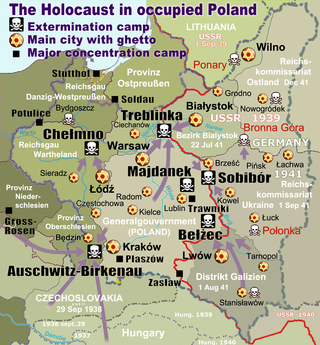
ŁachwaGhetto was a Nazi ghetto in Łachwa, Poland during World War II. The ghetto was created with the aim of persecution and exploitation of the local Jews. The ghetto existed until September 1942. One of the first Jewish ghetto uprisings had happened there.

The Pińsk Ghetto was a Nazi ghetto created by Nazi Germany for the confinement of Jews living in the city of Pińsk, Western Belarus. Pińsk, located in eastern Poland, was occupied by the Red Army in 1939 and incorporated into the Byelorussian SSR. The city was captured by the Wehrmacht in Operation Barbarossa in July 1941; it was incorporated into the German Reichskommissariat Ukraine in autumn of 1941.

Bronna Góra is the name of a secluded area in present-day Belarus where mass killings of Polish Jews were carried out by Nazi Germany during World War II. The location was part of the eastern half of occupied Poland, which had been invaded by the Soviet Union in 1939 in agreement with Germany, and two years later captured by the Wehrmacht in Operation Barbarossa. It is estimated that from May 1942 until November of that year, during the most deadly phase of the Holocaust in Poland, some 50,000 Jews were murdered at Bronna Góra forest in death pits. The victims were transported there in Holocaust trains from Nazi ghettos, including from the Brześć Ghetto and the Pińsk Ghetto, and from the ghettos in the surrounding area, as well as from Reichskommissariat Ostland.

World Congress of Mountain Jews (WCMJ) is an active, international non-governmental organization that provides opportunities for Mountain Jews, who are dispersed worldwide. WCMJ seeks to bring together the Mountain Jew population to maintain and share traditions and cultural values through cooperation with international society. The organisation plays an integral cultural role for Mountain Jews globally, through official representation of their interests – which includes engagement with governmental and social bodies. It brings together the mountain Jews of Israel, United States, Russia, Canada, Azerbaijan, Germany, Austria, Georgia, Kazakhstan, and other countries.
Word of the Righteous is a 2017 documentary series directed and produced by journalists Svitlana Levitas and Margarita Yakovleva, co-authors of a Ukrainian-Israeli-US project dedicated to the Righteous Among the Nations.

Alexander Vitalievich Gurevich is a Russian TV presenter, showman, producer and director. The host and creative director of the game show Hundred to One (1995–2022), a TEFI Award Laureate.

The Navahrudak Ghetto was established in December 1941 in Navahrudak, in the Byelorussian SSR, during the Holocaust. Almost all of its residents were killed - only 350 survived, and 10,000 perished.
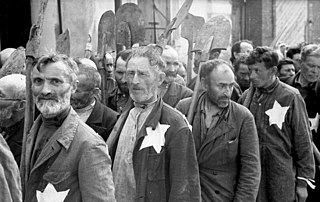
The Mogilev Ghetto was a Nazi ghetto in the city of Mogilev, in eastern Belarus, during World War II. Established shortly following the German victory in the Siege of Mogilev, around 10,000 Jews were killed by the Nazis and collaborationist forces by the time it was abolished in 1943.

The Ghetto in Svisloch was a ghetto for the forcefully relocated Jews of Svisloch in the Osipovichi district (Belarus), and nearby settlements. It was in operation during the Holocaust, from the summer of 1941 to autumn of 1942

















